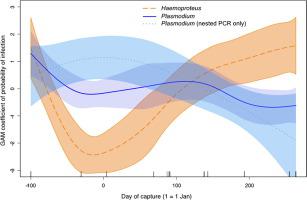International Journal for Parasitology ( IF 3.7 ) Pub Date : 2020-05-16 , DOI: 10.1016/j.ijpara.2020.03.008 Júlio Manuel Neto 1 , Samantha Mellinger 1 , Lucyna Halupka 2 , Alfonso Marzal 3 , Pavel Zehtindjiev 4 , Helena Westerdahl 1

|
Infectious diseases often vary seasonally in a predictable manner, and seasonality may be responsible for geographical differences in prevalence. In temperate regions, vector-borne parasites such as malaria are expected to evolve lower virulence and a time-varying strategy to invest more in transmission when vectors are available. A previous model of seasonal variation of avian malaria described a double peak in prevalence of Plasmodium parasites in multiple hosts resulting from spring relapses and transmission to susceptible individuals in summer. However, this model was rejected by a study describing different patterns of seasonal variation of two Plasmodium spp. at the same site, with the double peak only apparent when these species were combined. Here, we assessed the seasonal variation in prevalence of haemosporidian parasites (Plasmodium, Haemoproteus and Leucocytozoon) in house sparrows (Passer domesticus) sampled across 1 year at four temperate European sites spanning a latitudinal range of 17°. We showed that parasite prevalence and diversity decreased with increasing latitude, but the parasite communities differed between sites, with only one Plasmodium lineage (P_SGS1) occurring at all sites. Moreover, the nested PCR method commonly used to detect and identify haemosporidian parasites strongly underestimated co-infections of Haemoproteus and Plasmodium, significantly biasing the pattern of seasonal variation, so additional molecular methods were used. Finally, we showed that: (i) seasonal variation in prevalence of haemosporidian parasites varied between study sites and parasite lineages/species/genera, describing further cases where the double peak model is not met; (ii) the seasonal dynamics of single lineages (P_SGS1) varied between sites; and (iii) unexpectedly, seasonality was greatest at the southernmost site, a pattern that was mostly driven by lineage H_PADOM05. Limitations of the genotyping methods and consequences of pooling (parasite lineages, sites and years) in studies of haemosporidian parasites are discussed and recommendations proposed, since these actions may obscure the patterns of prevalence and limit ecological inferences.
中文翻译:

四个欧洲地点家麻雀 Passerdomesticus 中血孢子虫(Apicomplexa,Haemosporida)寄生虫的季节性动态:谱系之间的比较和筛选方法的重要性。
传染病通常以可预测的方式季节性变化,季节性可能是造成流行的地域差异的原因。在温带地区,疟疾等病媒传播的寄生虫预计会进化出较低的毒力,并会在有病媒可用时采取随时间变化的策略,在传播方面投入更多资金。先前的禽疟疾季节性变化模型描述了由于春季复发和夏季传播给易感个体而导致的多宿主中疟原虫寄生虫流行的双高峰。然而,该模型被一项描述两种疟原虫季节性变化的不同模式的研究拒绝了。属 在同一地点,双峰仅在这些物种组合时才明显。在这里,我们评估了haemosporidian寄生虫(流行季节变化疟原虫,Haemoproteus和住白细胞)的家麻雀(麻雀跨越1年采样)在四个温带欧洲的工厂跨越17度的纬度范围。我们发现寄生虫流行率和多样性随着纬度的增加而降低,但不同地点的寄生虫群落不同,所有地点都只有一种疟原虫谱系 (P_SGS1)。此外,通常用于检测和鉴定血孢子虫寄生虫的巢式 PCR 方法严重低估了血变形虫的合并感染和疟原虫,显着偏向季节性变化的模式,因此使用了额外的分子方法。最后,我们表明: (i) 血孢子虫寄生虫流行的季节性变化在研究地点和寄生虫谱系/物种/属之间有所不同,描述了不满足双峰模型的进一步情况;(ii) 单个谱系 (P_SGS1) 的季节性动态因地点而异;(iii) 出乎意料的是,最南端的季节性最强,这种模式主要由谱系 H_PADOM05 驱动。讨论了血孢子虫寄生虫研究中基因分型方法的局限性和汇集(寄生虫谱系、地点和年份)的后果,并提出了建议,因为这些行动可能会掩盖流行的模式并限制生态推断。











































 京公网安备 11010802027423号
京公网安备 11010802027423号